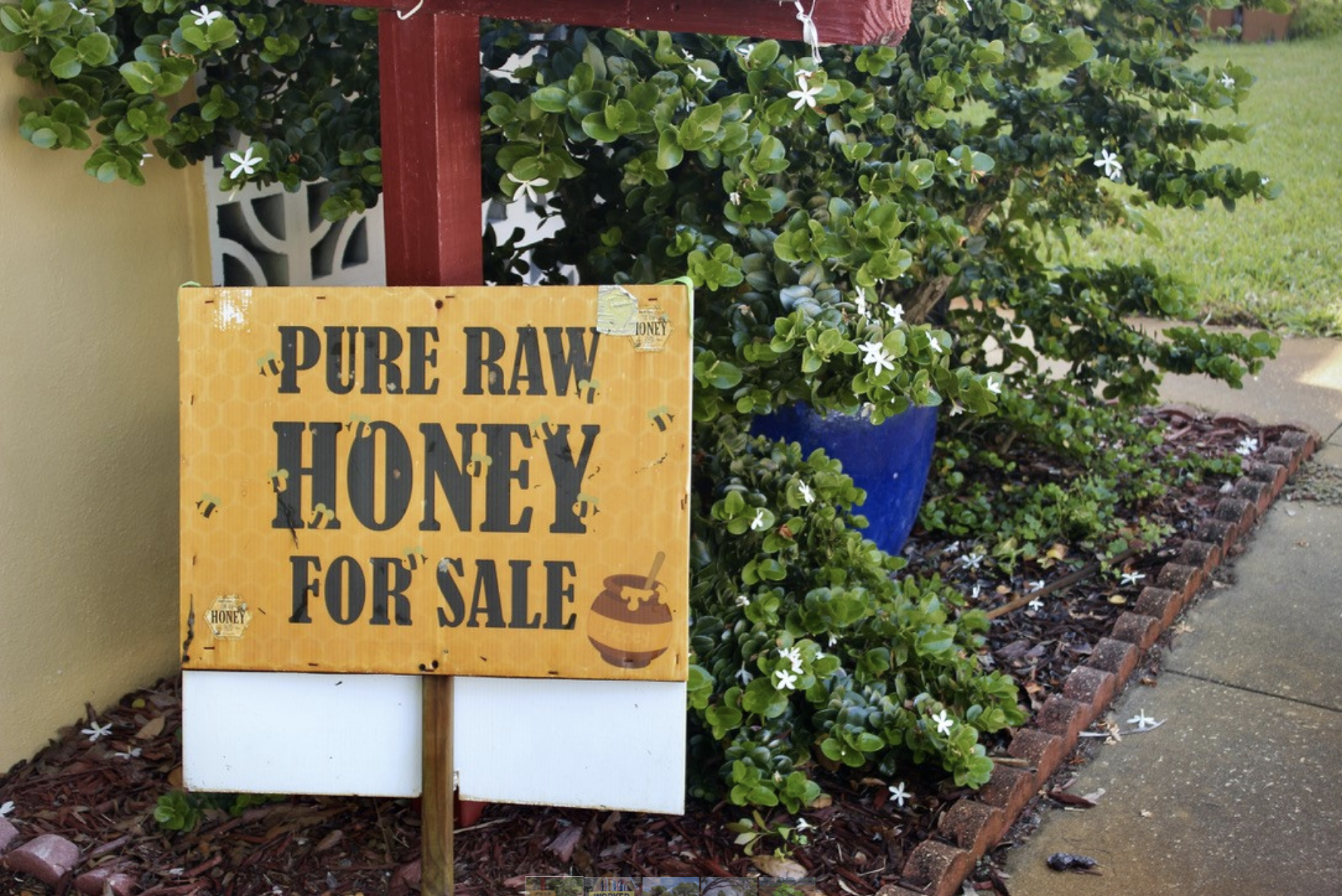
Author: Roxanne Hoorne
Some of St. Petersburg’s citizens recently rejoiced at the passing of Urban Agriculture Ordinance 488-H on December 3rd, 2020, aimed at loosening regulations on residential produce sales and community gardens. While proponents of the ordinance celebrate the enhanced opportunity for urban agriculture and its community benefits, critics question who is utilizing the policy, how the information is being distributed, and why we need these regulations at all.
Often, urban residents only become aware of an agricultural law when it gets in their way, which is exactly what happened to Derek Lewis, a South African beekeeper who traded in his African Killer Bees for the “less aggressive” European honey bees when he moved to St. Petersburg six years ago. “This was my problem right here,” Derek told me as he pointed to the sign reading “PURE RAW HONEY FOR SALE,” which he had retired from his front lawn. Derek claims that before being cited by a new City Home Inspector, “I had no idea it was illegal to sell your own honey,” a sentiment which has proven true for many residential urban producers.
Derek decided to challenge the city, bringing his bee crusade to the ongoing movement to loosen urban agriculture regulations in St. Pete. With the support of District 2 Council member, Brandi Gabbard, the goal of concerned community leaders and residents was to amend the city’s Land Development Regulations to make it easier for residents to sell their homegrown produce and address local food insecurity.
Proponents of the ordinance, such as Wendy Wesley, a civically engaged licensed St. Petersburg dietitian and nutritionist, believes that the ordinance is “a step in the right direction,” as it will help residents gain access to nutrient-dense food, especially in food insecure areas. She hopes “This access will mitigate the devastating effects of diabetes, cardiac disease, kidney failure,” and even the loneliness that she sees in her practice.
Urban Agriculture Ordinance 488-H made notable changes to existing laws expanding allotted frequency of sale of produce and garden infrastructure use, increasing maximum plant height, and reducing the cost of permits for community gardens and road side vendors.
Derek got his honey and could sell it too, just not quite as often as he’d hoped. “In a sense, I won, in that I now have permission to sell (honey) from home, with the limitations (of 36 times per year), which doesn’t particularly suit me.” Other individuals who pushed for the ordinance celebrated its passing. Carla Bristol, St. Pete Youth Farm Collaboration Manager, said that “It’s important policy and it lends support to the work we're doing here (at the Youth Farm),” where they seek to “create a space to grow food and grow as leaders, entrepreneurs, and as individuals while giving back to the community.”
Some critique that while the benefits of the ordinance are clear, there has been little action to educate the public on how to utilize the opportunity, and if people are not utilizing policy, then what is its purpose? Carla emphasizes that, “You’ve got to first make people aware that this is a thing.” Wendy calls for “massive scale knowledge of this (ordinance) city-wide,” recommending that an educational flyer could potentially go out with a water bill, something everyone will see. The City of St. Petersburg and initiatives such as Healthy St.Pete were noted as being well positioned to play a role in disseminating this information to all St. Pete residents.
While concerned citizens generally recognize the importance of the ordinance and celebrate its passing, some share Derek’s sentiments that the current loosening of restrictions isn’t nearly good enough. Assistant professor and founder of the Urban Food Sovereignty Group at USF, William “Will” Schanbacher, remarked that when it comes to policy, “One of the best things we can do is remove barriers for food insecure communities…without asking them to fill out any paperwork,” leading Will to question the purpose of these regulations on selling your own homegrown food in the first place.
When asked this same question, Elizabeth Abernethy, AICP Director, Planning & Development Services, City of St. Petersburg said, “Retail activities are not allowed in residential zoning districts…Unlimited commercial activities in residential districts can impact the health, safety and welfare of residents, and have not been allowed under zoning regulations first established in our City in the 1920s.”
Historically, there is a combination of laws labeling urban agricultural spaces as nuisances and the resulting zoning that aimed to separate residential, commercial, and agricultural spaces, all of which have deep roots that are gradually being overturned with the growth of urban agriculture.
Deeper systemic issues that stem in part from these outdated and restrictive agricultural laws still impact people today. Not only have laws restricted where and how food can be grown and sold, but making it a legal “nuisance” to grow food in residential spaces has disrupted and criminalized culture, especially among Black and immigrant populations. “I see us returning to the same traditions, and we are now having to rebuild what was already there,” says Carla. Agricultural knowledge and the appreciation that comes with your proximity to where your food is grown has been denied to many people in recent generations. Carla wants youth to know that “There is dignity in being able to grow food and being able to have control over where your food comes from.”
This serves to emphasize not only the importance of revising these outdated policies, but the importance of the Youth Farm and other groups dedicated to sharing food, knowledge, and a sense of community, especially amongst the next generation. Wendy notes that from a health standpoint, “It’s not just about creating food… Gardens and farms are a 360-degree approach to health and wellness, not only for the food, but for the exercise and connection to human beings.”
This ordinance, as well as the multiple local urban agricultural laws that have been amended in recent years, was greatly influenced by the voices and actions of concerned citizens. In Carla’s words, “Help me, help you, help us,” she expresses that when it comes to alleviating food insecurity, especially in populations that have been systematically denied access, do not assume that free food and aid programs are the best way forward.
When given the opportunity, via resources and the support of policy, community resilience will be the source of thriving.
 Roxanne Hoorne is passionate about communications and journalism concerning equity in food and climate issues. She is also interested in the intersection of art, science, and philosophy. Roxanne has worked extensively with non-profits in research and communications concerning these issues both locally and internationally, as well as in the arts, both as an employee and volunteer. She is a Florida Food Policy Council member and contributes to their newsletter. She hopes her writing not only informs readers but also inspires their engagement.
Roxanne Hoorne is passionate about communications and journalism concerning equity in food and climate issues. She is also interested in the intersection of art, science, and philosophy. Roxanne has worked extensively with non-profits in research and communications concerning these issues both locally and internationally, as well as in the arts, both as an employee and volunteer. She is a Florida Food Policy Council member and contributes to their newsletter. She hopes her writing not only informs readers but also inspires their engagement.
Disclaimer: The views of the writers do not represent the views of the Florida Food Policy Council. We are a forum for the offering and sharing of information and encourage diversity and communication within the food system.